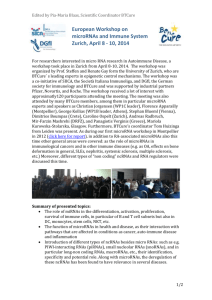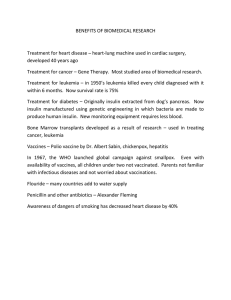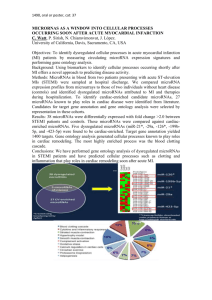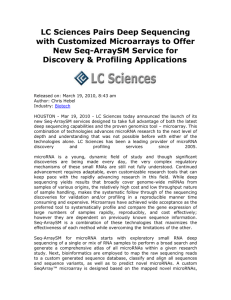MicroRNAs: the primary cause or a determinant of progression in leukemia?
advertisement
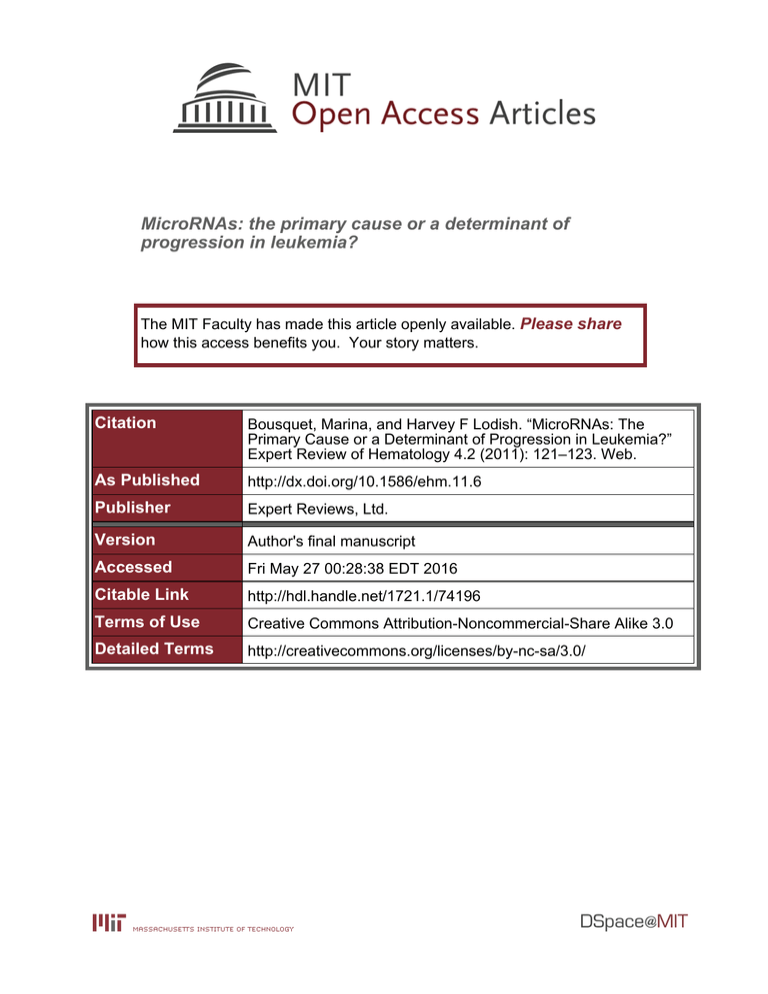
MicroRNAs: the primary cause or a determinant of progression in leukemia? The MIT Faculty has made this article openly available. Please share how this access benefits you. Your story matters. Citation Bousquet, Marina, and Harvey F Lodish. “MicroRNAs: The Primary Cause or a Determinant of Progression in Leukemia?” Expert Review of Hematology 4.2 (2011): 121–123. Web. As Published http://dx.doi.org/10.1586/ehm.11.6 Publisher Expert Reviews, Ltd. Version Author's final manuscript Accessed Fri May 27 00:28:38 EDT 2016 Citable Link http://hdl.handle.net/1721.1/74196 Terms of Use Creative Commons Attribution-Noncommercial-Share Alike 3.0 Detailed Terms http://creativecommons.org/licenses/by-nc-sa/3.0/ NIH Public Access Author Manuscript Expert Rev Hematol. Author manuscript; available in PMC 2011 October 10. NIH-PA Author Manuscript Published in final edited form as: Expert Rev Hematol. 2011 April ; 4(2): 121–123. doi:10.1586/ehm.11.6. MicroRNAs: the primary cause or a determinant of progression in leukemia? Marina Bousquet and Whitehead Institute for Biomedical Research, Nine Cambridge Center, Cambridge, MA 02142, USA Harvey F Lodish Whitehead Institute for Biomedical Research, Nine Cambridge Center, Cambridge, MA 02142, USA and Department of Biology, Massachusetts Institute of Technology, Cambridge, MA 02138, USA Marina Bousquet: bousquet@wi.mit.edu NIH-PA Author Manuscript Keywords diagnostic tool; leukemia; microRNA; oncogene; prognostic tool; tumor suppressor gene Leukemia is a complex disease with many different types and subtypes caused by a huge diversity of genetic and epigenetic aberrations. Until recently, alterations of protein-coding genes were thought to be the sole cause of tumorigenesis. With the recent discovery of multiple types of non-coding RNAs, it has become evident that mutations in these also contribute to the development of cancer. Among the non-coding RNAs, microRNAs play a crucial role in cancer owing to their involvement in fundamental processes such as apoptosis, differentiation and proliferation [1,2]. NIH-PA Author Manuscript MicroRNAs are small noncoding RNAs (approximately 19–25 nucleotides in length) that bind to and downregulate multiple mRNA targets; in mammals, the production of over a third of all proteins is regulated by microRNAs [3]. Several studies demonstrated that microRNAs are involved in leukemia progression but their role as the primary cause or a determinant of progression in leukemia has been unclear. Some have been identified as oncogenes or tumor suppressor genes, which suggests that they are playing a central role in tumorigenesis, while others appear to be associated with a specific stage in disease progression. Deciphering the exact role of microRNAs in oncogenesis is important in order to improve the diagnosis and treatment of leukemia patients. © 2011 Expert Reviews Ltd Correspondence to: Marina Bousquet, bousquet@wi.mit.edu. For reprint orders, please contact reprints@expert-reviews.com Financial & competing interests disclosure Marina Bousquet was supported by a fellowship from the Leukemia and Lymphoma Foundation and Association pour la Recherche sur le Cancer (ARC). This work was also supported by NIH grants DK068348 and 5P01 HL066105 awarded to Harvey F Lodish. The authors have no other relevant affiliations or financial involvement with any organization or entity with a financial interest in or financial conflict with the subject matter or materials discussed in the manuscript apart from those disclosed. No writing assistance was utilized in the production of this manuscript. Bousquet and Lodish Page 2 MicroRNAs: oncogenes & tumor suppressor genes NIH-PA Author Manuscript Several publications have showed that microRNAs function as oncogenes or tumor suppressor genes [4]. By definition, the deletion or the downregulation of a tumor suppressor gene leads to the activation of an oncogene. For example, miR-15a and miR-16-1 are frequently deleted in chronic lymphocytic leukemia (CLL) and their deletion leads to an upregulation of the anti-apoptotic BCL-2 oncogene [5]. In mice, deletion of miR-15a and miR-16-1 causes CLL [6]. On the other hand, an oncomiR is a microRNA whose upregulation promotes tumorigenesis by downmodulating tumor suppressor genes. The first example of an oncomiR was identified in 2005 with the description of the amplification of the polycistronic miR-17-92 cluster in B-cell lymphoma [7]. In mice, forced expression of miR-17-92 cooperates with cMYC to promote tumorigenesis [7]. In that scenario, miR-17-92 acts as a secondary event with the ability to increase the oncogenicity of the c-MYC oncogene. A similar conclusion was established with a transgenic mouse in which miR-155 was overexpressed in B cells [8]. These mice developed poly-clonal preleukemic pre-B-cell proliferation followed by B-cell malignancy. This result suggests that miR-155 deregulation is an early event in the oncogenic process and needs a secondary hit to generate a fully malignant phenotype. Han et al. demonstrated that mice overexpressing miR-29a developed a myeloproliferative disorder that progresses to acute myeloid leukemia (AML) [9]. NIH-PA Author Manuscript We previously described the overexpression of miR-125b in patients with AML and myelodysplasia with the t(2;11)(p21;q23) chromosomal translocation [10]. Mice transplanted with hematopoietic progenitors overexpressing miR-125b showed an increase in neutrophils and monocytes, associated with a macrocytic anemia [11]. Among these mice, half of them died of B-cell acute lymphoblastic leukemia, T-cell acute lymphoblastic leukemia, or a myeloproliferative neoplasm, suggesting an important role for miR-125b early on in hematopoiesis [11]. It is likely that additional mutations contributed to the leukemic transformation. Interestingly, O’Connell et al. and Ooi et al. used the same strategy to study the role of miR-125b in vivo, but their results were different. O’Connell et al. demonstrated that miR-125b overexpression led to AML in all mice but no leukemic phenotype was observed in Ooi’s study [12,13]. As the major difference was the level of overexpressed miR-125b, these results suggest that a microRNA can have different effects depending on its level of expression and thus the numbers or types of mRNAs that are downmodulated. In addition, we demonstrated that miR-125b was able to cooperate with BCR-ABL to promote tumorigenesis in a transplanted mouse model [11]. This finding suggests that miR-125b can also act as a secondary event in oncogenesis. NIH-PA Author Manuscript MicroRNA expression profile: a diagnostic tool? The diagnosis and prognosis of leukemia currently depend on morphologic observation and the detection of a variety of molecular and cytogenetic abnormalities. However, even in a specific well-defined subtype there is significant variability between patients. The new level of complexity added by microRNAs appears to be helpful in defining specific microRNA signatures associated with predicting clinical outcomes. As microRNAs are usually expressed in a lineage-specific manner, microRNA signatures have been employed to differentiate AML from acute lymphoid leukemia (ALL) [14]. Indeed, expression profiling revealed 27 microRNAs differentially expressed between AML and ALL. In particular, miR-128a, miR-128b, miR-let-7b and miR-223 expression can distinguish AML from ALL, with a diagnosis accuracy of >95% [14]. MicroRNA profiles can also identify different subtypes of leukemia. For example, the tumor suppressors let-7b and let-7c are downregulated in AML patients with t(8;21) and inv(16) [15]. MicroRNAs 382, 134, 376a, Expert Rev Hematol. Author manuscript; available in PMC 2011 October 10. Bousquet and Lodish Page 3 NIH-PA Author Manuscript 127, 299–5p and 323 are highly expressed in AML with the t(15;17) translocation [15]. Downregulation of miR-127 has been reported in AML with inv(16), while upregulation of miR-155 has been identified in AML patients with the FLT3-ITD mutation [15,16]. Moreover, upregulation of microRNAs 10a, 10b, 196a and 196b and downregulation of miR-204 and 128 are associated with NPM1 mutations in AML patients [15,16]. In AML with CEBPA mutations, microRNAs 181a, 335 and 124 are upregulated [15,17]. In ALL patients, eight microRNAs including miR-708 and miR-196b can distinguish subtypes of ALL, with or without mixed lineage leukemia rearrangement [18]. Thus, the microRNA expression profile can be used to define certain subtypes of leukemia, but additional studies are needed to understand the involvement of these microRNAs in disease progression. MicroRNA signatures: prognostic tool for disease progression Calin et al. identified a unique signature of 13 microRNAs associated with prognostic factors and disease progression in CLL. They screened 94 CLL patients and found that low expression of miR-15a and miR-16-1 was associated with a good prognosis and downregulation of microRNAs in the miR-29 family was associated with a poor prognosis [19]. NIH-PA Author Manuscript Another example is the upregulation of the miR-17–92 cluster, which has been reported in the chronic phase but not during blast crisis of chronic myeloid leukemia (CML) [20]. Furthermore, downregulation of miR-17–92 was observed upon imatinib treatment in CML cell lines, which suggests a control of the chronic phase by these microRNAs [20]. Eiring et al. reported that low expression of miR-328 in CML is associated with progression to the blast crisis phase of the disease [21]. Garzon et al. demonstrated that abnormally high levels of miR-191 and miR-199a were associated with poor overall survival in patients with AML [22]. Taking all these observations together, we conclude that microRNAs play a crucial role in cancer. Similar to protein-coding genes, microRNAs participate both in the oncogenic transformation event and in disease progression. Oncogenesis is a multi-step process which includes an accumulation of mutations over time, and with most microRNAs it is still difficult to decipher alterations in their expression as primary or secondary events. NIH-PA Author Manuscript Many signatures found in different subtypes of leukemia have been confirmed in multiple studies, which suggests that changes in microRNA expression levels are actively involved in the cancer process and are not just random events. We still need to discriminate between microRNAs that are deregulated as a consequence of the disease state and microRNAs whose deregulation contributes actively to disease progression. Some microRNAs, such as miR-125b, appear to be sufficient to induce leukemia but we cannot exclude cooperation with other mutations in the transformation process. We also do not know whether miR-125b upregulation is necessary for disease initiation or progression. Another layer of complexity is that some microRNAs can have different effects depending on cellular context or expression level. For example, miR-29 is a tumor suppressor gene in CLL, while in breast cancer it acts as an oncogene [23]. Similarly, miR-125b overexpression causes leukemia but miR-125b downregulation was found to be associated with breast cancer [11,24]. Identification of genes targeted for downregulation by oncogenic microRNAs will be an important step in understanding their role in cancer. Mouse models are also useful but sometimes differences in microRNA expression patterns or mRNA targets in different species are a limitation. A better understanding of microRNA biology will help decipher the Expert Rev Hematol. Author manuscript; available in PMC 2011 October 10. Bousquet and Lodish Page 4 molecular mechanisms of tumorigenesis and define new therapeutic strategies against cancer. NIH-PA Author Manuscript References NIH-PA Author Manuscript NIH-PA Author Manuscript 1. Bartel DP. MicroRNAs: genomics, biogenesis, mechanism, and function. Cell. 2004; 116(2):281– 297. [PubMed: 14744438] 2. Kim VN. MicroRNA biogenesis: coordinated cropping and dicing. Nat Rev Mol Cell Biol. 2005; 6(5):376–385. [PubMed: 15852042] 3. Lewis BP, Burge CB, Bartel DP. Conserved seed pairing, often flanked by adenosines, indicates that thousands of human genes are microRNA targets. Cell. 2005; 120(1):15–20. [PubMed: 15652477] 4. Fabbri M, Croce CM, Calin GA. MicroRNAs. Cancer J. 2008; 14(1):1–6. [PubMed: 18303474] 5. Calin GA, Dumitru CD, Shimizu M, et al. Frequent deletions and down-regulation of micro-RNA genes miR15 and miR16 at 13q14 in chronic lymphocytic leukemia. Proc Natl Acad Sci USA. 2002; 99(24):15524–15529. [PubMed: 12434020] 6. Klein U, Lia M, Crespo M, et al. The DLEU2/miR-15a/16–11 cluster controls B cell proliferation and its deletion leads to chronic lymphocytic leukemia. Cancer Cell. 2010; 17(1):28–40. [PubMed: 20060366] 7. He L, Thomson JM, Hemann MT, et al. A microRNA polycistron as a potential human oncogene. Nature. 2005; 435(7043):828–833. [PubMed: 15944707] 8. Costinean S, Zanesi N, Pekarsky Y, et al. Pre-B cell proliferation and lymphoblastic leukemia/highgrade lymphoma in E(mu)-miR155 transgenic mice. Proc Natl Acad Sci USA. 2006; 103(18):7024– 7029. [PubMed: 16641092] 9. Han YC, Park CY, Bhagat G, et al. microRNA-29a induces aberrant self-renewal capacity in hematopoietic progenitors, biased myeloid development, and acute myeloid leukemia. J Exp Med. 2010; 207(3):475–489. [PubMed: 20212066] 10. Bousquet M, Quelen C, Rosati R, et al. Myeloid cell differentiation arrest by miR-125b-1 in myelodysplastic syndrome and in addition with the t(2;11)(p21;q23) translocation. J Exp Med. 2008; 205(11):2499–2506. [PubMed: 18936236] 11. Bousquet M, Harris MH, Zhou B, Lodish HF. MicroRNA miR-125b causes leukemia. Proc Natl Acad Sci USA. 2010 (Epub ahead of print). 10.1073/pnas.1016611107 12. O’Connell RM, Chaudhuri AA, Rao DS, Gibson WS, Balazs AB, Baltimore D. MicroRNAs enriched in hematopoietic stem cells differentially regulate long-term hematopoietic output. Proc Natl Acad Sci USA. 2010; 107(32):14235–14240. [PubMed: 20660734] 13. Ooi AG, Sahoo D, Adorno M, Wang Y, Weissman IL, Park CY. MicroRNA-125b expands hematopoietic stem cells and enriches for the lymphoid-balanced and lymphoid-biased subsets. Proc Natl Acad Sci USA. 2010; 107(50):21505–21510. [PubMed: 21118986] 14. Mi S, Lu J, Sun M, et al. MicroRNA expression signatures accurately discriminate acute lymphoblastic leukemia from acute myeloid leukemia. Proc Natl Acad Sci USA. 2007; 104(50): 19971–19976. [PubMed: 18056805] 15. Jongen-Lavrencic M, Sun SM, Dijkstra MK, Valk PJ, Lowenberg B. MicroRNA expression profiling in relation to the genetic heterogeneity of acute myeloid leukemia. Blood. 2008; 111(10): 5078–5085. [PubMed: 18337557] 16. Garzon R, Garofalo M, Martelli MP, et al. Distinctive microRNA signature of in addition bearing cytoplasmic mutated nucleophosmin. Proc Natl Acad Sci USA. 2008; 105(10):3945–3950. [PubMed: 18308931] 17. Marcucci G, Maharry K, Radmacher MD, et al. Prognostic significance of, and gene and microRNA expression signatures associated with, CEBPA mutations in cytogenetically normal in addition with high-risk molecular features: a Cancer and Leukemia Group B Study. J Clin Oncol. 2008; 26(31):5078–5087. [PubMed: 18809607] 18. Schotte D, Chau JC, Sylvester G, et al. Identification of new microRNA genes and aberrant microRNA profiles in childhood acute lymphoblastic leukemia. Leukemia. 2009; 23(2):313–322. [PubMed: 18923441] Expert Rev Hematol. Author manuscript; available in PMC 2011 October 10. Bousquet and Lodish Page 5 NIH-PA Author Manuscript 19. Calin GA, Ferracin M, Cimmino A, et al. A microRNA signature associated with prognosis and progression in chronic lymphocytic leukemia. N Engl J Med. 2005; 353(17):1793–1801. [PubMed: 16251535] 20. Venturini L, Battmer K, Castoldi M, et al. Expression of the miR-17–92 polycistron in chronic myeloid leukemia (CML) CD34+ cells. Blood. 2007; 109(10):4399–4405. [PubMed: 17284533] 21. Eiring AM, Harb JG, Neviani P, et al. miR-328 functions as an RNA decoy to modulate hnRNP E2 regulation of mRNA translation in leukemic blasts. Cell. 2010; 140(5):652–665. [PubMed: 20211135] 22. Garzon R, Volinia S, Liu CG, et al. MicroRNA signatures associated with cytogenetics and prognosis in acute myeloid leukemia. Blood. 2008; 111(6):3183–3189. [PubMed: 18187662] 23. Pekarsky Y, Croce CM. Is miR-29 an oncogene or tumor suppressor in CLL? Oncotarget. 2010; 1(3):224–227. [PubMed: 20936047] 24. Iorio MV, Ferracin M, Liu CG, et al. MicroRNA gene expression deregulation in human breast cancer. Cancer Res. 2005; 65(16):7065–7070. [PubMed: 16103053] Biographies NIH-PA Author Manuscript NIH-PA Author Manuscript Expert Rev Hematol. Author manuscript; available in PMC 2011 October 10.
